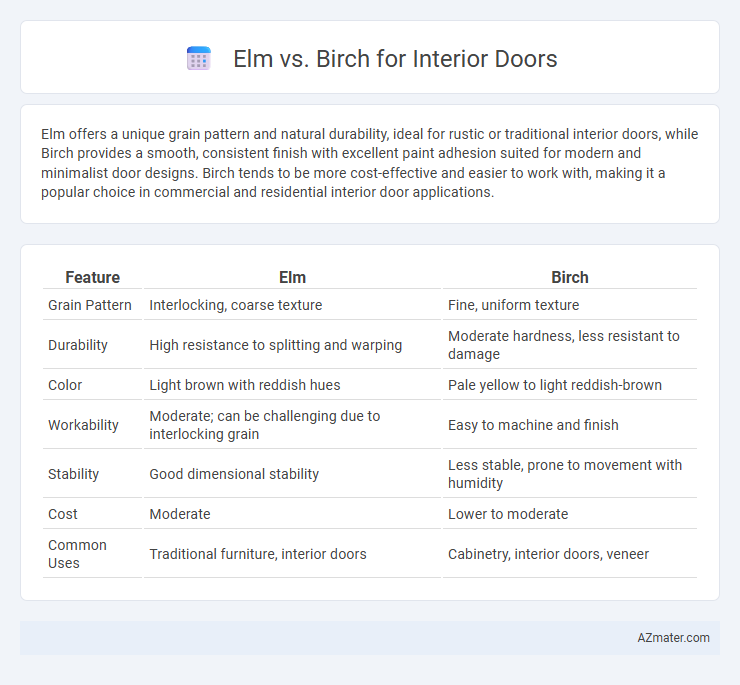Elm offers a unique grain pattern and natural durability, ideal for rustic or traditional interior doors, while Birch provides a smooth, consistent finish with excellent paint adhesion suited for modern and minimalist door designs. Birch tends to be more cost-effective and easier to work with, making it a popular choice in commercial and residential interior door applications.
Table of Comparison
| Feature | Elm | Birch |
|---|---|---|
| Grain Pattern | Interlocking, coarse texture | Fine, uniform texture |
| Durability | High resistance to splitting and warping | Moderate hardness, less resistant to damage |
| Color | Light brown with reddish hues | Pale yellow to light reddish-brown |
| Workability | Moderate; can be challenging due to interlocking grain | Easy to machine and finish |
| Stability | Good dimensional stability | Less stable, prone to movement with humidity |
| Cost | Moderate | Lower to moderate |
| Common Uses | Traditional furniture, interior doors | Cabinetry, interior doors, veneer |
Introduction to Elm and Birch Wood
Elm wood features an interlocking grain that provides exceptional strength and resistance to splitting, making it ideal for interior doors subjected to frequent use. Birch wood is characterized by a fine, even grain and pale color, offering a smooth finish and excellent durability for contemporary interior door designs. Both woods are valued for their workability and aesthetic appeal, yet elm's moisture resistance makes it preferable in humid environments while birch offers greater consistency in texture and color.
Key Characteristics of Elm Wood
Elm wood used for interior doors is renowned for its interlocking grain, which provides excellent resistance to splitting and warping, making it highly durable. The wood's natural elasticity and shock resistance contribute to long-lasting door performance in varying humidity conditions. Its rich texture and warm, reddish-brown hues enhance aesthetic appeal while maintaining structural stability.
Key Characteristics of Birch Wood
Birch wood, known for its fine, even grain and pale color, offers a smooth finish ideal for interior doors requiring a clean, modern aesthetic. It is a hard and durable hardwood, providing strength and resistance to wear, making it suitable for high-traffic areas. Birch also takes paint and stain well, allowing for versatile design options compared to the more textured and contrasting grain of elm.
Aesthetic Differences: Elm vs Birch
Elm wood exhibits a distinctive, pronounced grain pattern with interlocking fibers, creating a wavy, textured appearance that adds rustic charm and warmth to interior doors. Birch features a smoother, more uniform grain with subtle variations and a lighter, creamier color, offering a clean, modern aesthetic ideal for contemporary interiors. The choice between elm and birch for interior doors significantly impacts the visual appeal, with elm emphasizing natural texture and character, while birch provides a sleek and refined look.
Durability and Hardness Comparison
Elm offers excellent durability with medium hardness, making it resistant to splitting and warping, ideal for stable interior doors. Birch features higher hardness and density, providing superior resistance to dents and scratches, which enhances its longevity in high-traffic areas. The choice between Elm and Birch depends on the need for toughness versus impact resistance for interior door applications.
Cost and Availability
Elm offers moderate cost and is moderately available, making it a practical choice for interior doors with unique grain patterns and natural durability. Birch tends to be more affordable and widely available due to its fast growth and common use in furniture, resulting in consistent supply and budget-friendly pricing. Choosing between elm and birch primarily depends on balancing budget constraints with desired aesthetics and wood characteristics in interior door applications.
Workability and Finishing Qualities
Elm offers excellent workability due to its interlocking grain, reducing tear-out and allowing smooth cutting and shaping, which makes it suitable for intricate door designs. Birch features a fine, even grain that sands to a smooth finish, accepting stains and paints uniformly, resulting in a polished and consistent appearance for interior doors. Both woods respond well to finishing processes, but birch's close grain provides superior smoothness, while elm's unique grain offers distinctive texture and durability.
Environmental Impact and Sustainability
Elm is a hardwood known for its durability and resistance to splitting, often sourced from mature trees that can take decades to regrow, creating moderate environmental impact. Birch, typically harvested from fast-growing trees, offers a more sustainable option due to quicker regeneration and efficient forest management practices. Choosing birch for interior doors supports reduced deforestation and lower carbon footprint compared to slower-growing hardwoods like elm.
Best Use Cases for Each Wood Type
Elm's interlocking grain and durability make it ideal for interior doors that require resistance to wear and impact, such as entryways and high-traffic rooms. Birch offers a smooth texture and uniform grain, perfect for doors with a painted finish or modern design schemes where a clean, consistent appearance is desired. Elm suits rustic or traditional interiors due to its prominent grain patterns, while birch complements minimalist and contemporary styles with its subtle, refined look.
Conclusion: Choosing the Right Wood for Your Interior Door
Elm offers remarkable durability and distinctive grain patterns that bring a warm, rustic charm to interior doors, making it a reliable choice for high-traffic areas. Birch provides a smooth, fine texture with a light color that suits modern and minimalist designs, offering an affordable yet sturdy option. Selecting the right wood for your interior door depends on balancing aesthetic preferences, durability requirements, and budget constraints to ensure the perfect match for your home's interior style.

Infographic: Elm vs Birch for Interior Door
 azmater.com
azmater.com